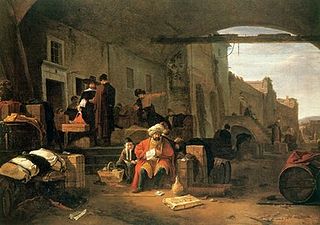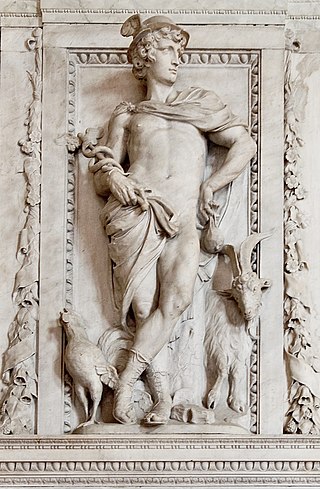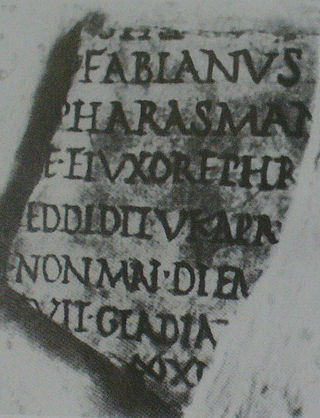
A merchant is a person who trades in commodities produced by other people, especially one who trades with foreign countries. Historically, a merchant is anyone who is involved in business or trade. Merchants have operated for as long as industry, commerce, and trade have existed. In 16th-century Europe, two different terms for merchants emerged: meerseniers referred to local traders and koopman referred to merchants who operated on a global stage, importing and exporting goods over vast distances and offering added-value services such as credit and finance.

Mercury is a major god in Roman religion and mythology, being one of the 12 Dii Consentes within the ancient Roman pantheon. He is the god of financial gain, commerce, eloquence, messages, communication, travelers, boundaries, luck, trickery, and thieves; he also serves as the guide of souls to the underworld and the "messenger of the gods".

Ancient Roman architecture adopted the external language of classical ancient Greek architecture for the purposes of the ancient Romans, but was different from Greek buildings, becoming a new architectural style. The two styles are often considered one body of classical architecture. Roman architecture flourished in the Roman Republic and to an even greater extent under the Empire, when the great majority of surviving buildings were constructed. It used new materials, particularly Roman concrete, and newer technologies such as the arch and the dome to make buildings that were typically strong and well engineered. Large numbers remain in some form across the former empire, sometimes complete and still in use today.

Ostia Antica was an ancient Roman city and the port of Rome located at the mouth of the Tiber. It is near modern Ostia, 25 kilometres southwest of Rome. Due to silting and the invasion of sand, the site now lies 3 km (2 mi) from the sea. The name Ostia derives from Latin os 'mouth'.

A Mithraeum(Latin pl. Mithraea), sometimes spelled Mithreum and Mithraion, is a Mithraic temple, erected in classical antiquity by the worshippers of Mithras. Most Mithraea can be dated between 100 BC and 300 AD, mostly in the Roman Empire.

Palestrina is a modern Italian city and comune (municipality) with a population of about 22,000, in Lazio, about 35 kilometres east of Rome. It is connected to the latter by the Via Prenestina. It is built upon the ruins of the ancient city of Praeneste.

Pozzuoli is a city and comune of the Metropolitan City of Naples, in the Italian region of Campania. It is the main city of the Phlegrean Peninsula.

Roman commerce was a major sector of the Roman economy during the later generations of the Republic and throughout most of the imperial period. Fashions and trends in historiography and in popular culture have tended to neglect the economic basis of the empire in favor of the lingua franca of Latin and the exploits of the Roman legions. The language and the legions were supported by trade and were part of its backbone. The Romans were businessmen, and the longevity of their empire was caused by their commercial trade.

A guildhall, also known as a "guild hall" or "guild house", is a historical building originally used for tax collecting by municipalities or merchants in Great Britain and the Low Countries. These buildings commonly become town halls and in some cases museums while retaining their original names.

The Temple of Vesta, or the aedes, is an ancient edifice in Rome, Italy. It is located in the Roman Forum near the Regia and the House of the Vestal Virgins. The Temple of Vesta housed Vesta's holy fire, which was a symbol of Rome's safety and prosperity. The temple has a circular footprint, making it a tholos.

The Milliarium Aureum, also known by the translation Golden Milestone, was a monument, probably of marble or gilded bronze, erected by the Emperor Augustus near the Temple of Saturn in the central Forum of Ancient Rome. All roads were considered to begin at this monument and all distances in the Roman Empire were measured relative to it. On it perhaps were listed all the major cities in the empire and distances to them, though the monument's precise location and inscription remain matters of debate among historians.

The praefectus urbanus, also called praefectus urbi or urban prefect in English, was prefect of the city of Rome, and later also of Constantinople. The office originated under the Roman kings, continued during the Republic and Empire, and held high importance in late Antiquity. The office survived the collapse of the Western Roman Empire, and the last urban prefect of Rome, named Iohannes, is attested in 599. In the East, in Constantinople, the office survived until the 13th century.

The Fasti Ostienses are a calendar of Roman magistrates and significant events from 49 BC to AD 175, found at Ostia, the principal seaport of Rome. Together with similar inscriptions, such as the Fasti Capitolini and Fasti Triumphales at Rome, the Fasti Ostienses form part of a chronology known as the Fasti Consulares, or Consular Fasti.

In ancient Roman religion and myth, Hercules was venerated as a divinized hero and incorporated into the legends of Rome's founding. The Romans adapted Greek myths and the iconography of Heracles into their own literature and art, but the hero developed distinctly Roman characteristics. Some Greek sources as early as the 6th and 5th century BC gave Heracles Roman connections during his famous labors.

September or mensis September was originally the seventh of ten months on the ancient Roman calendar that began with March. It had 29 days. After the reforms that resulted in a 12-month year, September became the ninth month, but retained its name. September followed what was originally Sextilis, the "sixth" month, renamed Augustus in honor of the first Roman emperor, and preceded October, the "eighth" month that like September retained its numerical name contrary to its position on the calendar. A day was added to September in the mid-40s BC as part of the Julian calendar reform.

The preservation and extensive excavations at Ostia Antica have brought to light 26 different bath complexes in the town. These range from large public baths, such as the Forum Baths, to smaller most likely private ones such as the small baths. It is unclear from the evidence if there was a fee charged or if they were free. Baths in Ostia would have served both a hygienic and a social function like in many other parts of the Roman world. Bath construction increased after an aqueduct was built for Ostia in the early Julio-Claudian Period. Many of the baths follow simple row arrangements, with one room following the next, due to the density of buildings in Ostia. Only a few, like the Forum Baths or the Baths of the Swimmers, had the space to include palestra. Archaeologist name the bathhouses from features preserved for example the inscription of Buticoso in building I, XIV, 8 lead to the name Bath of Buticosus or the mosaic of Neptune in building II, IV, 2 lead to the Baths of Neptune. The baths in Ostia follow the standard numbering convention by archaeologists, who divided the town into five regions, numbered I to V, and then identified the individual blocks and buildings as follows: (region) I, (block) I, (building) 1.

In Imperial Rome, Cura Annonae was the import and distribution of grain to the residents of the cities of Rome and, after its foundation, Constantinople. The term was used in honour of the goddess Annona. The city of Rome imported all the grain consumed by its population, estimated to number 1,000,000 by the 2nd century AD. This included recipients of the grain dole or corn dole, a government program which gave out subsidized grain, then free grain, and later bread, to about 200,000 of Rome's adult male citizens. Rome's grain subsidies were originally ad hoc emergency measures taken to import cheap grain from trading partners and allies at times of scarcity, to help feed growing numbers of indebted and dispossessed citizen-farmers. By the end of the Republic, grain subsidies and doles had become permanent, uniquely Roman institutions. The grain dole was reluctantly adopted by Augustus and later emperors as a free monthly issue to those who qualified to receive it. In 22 AD, Augustus' successor Tiberius publicly acknowledged the Cura Annonae as a personal and imperial duty, which if neglected would cause "the utter ruin of the state".

The Museo delle Mura is an archaeological museum in Rome, Italy. It is housed in the first and second floors of the Porta San Sebastiano at the beginning of the Appian Way. It provides an exhibition on the walls of Rome and their building techniques, as well as the opportunity to walk along the inside of one of the best-preserved stretches of the Aurelian Wall. The museum is free of charge.

Portus Magnus was a Roman port in western Mauretania Caesariensis. It was located near Roman Portus Divinus and actual Oran (Algeria).





















